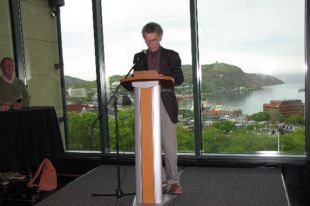Affiliation: The Provincial Museum of Newfoundland & Labrador

Kevin McAleese is with Provincial Museum of Newfoundland & Labrador (The Rooms in St. John’s), where he was the Curator of Archaeology and Ethnology for over 18 years. He holds his degrees from the Memorial University of Newfoundland and Simon Fraser University, and his areas of specialization include the Norse in the North Atlantic (including interactions with Skraelings and the saga history of Vinland), the early settlement history of Iceland, Greenland, and Vinland, and the late prehistory of Newfoundland and Labrador. He has conducted fieldwork in Newfoundland and Labrador, British Columbia, and Iceland, and his Norse-related publications include “Falling into Vinland: Newfoundland Hunting Pitfalls at the Edge of the Viking World” (with co-authors: J. Kristjansson, B. Einarsson, K. Jonasson, and T. Hjaltalin) in Acta Archaeologica Vol. 83, 2012.
The settling of Vinland (Newfoundland and Labrador) by the Viking Age Norse marked their furthest westward expansion c. A.D. 1000. Although the Norse appear to have lived at L’Anse aux Meadows in northern Newfoundland for only about 20 years, it was a tremendous achievement. Their journey to Vinland, part of a migratory process, was preceded by first colonising Iceland c. AD 850 and then Greenland c. AD 985. Sailing further westward only a few years later to settle at L’Anse aux Meadows was quite remarkable.
But when the Norse arrived they met resident people who had settled the region much earlier. The lifeway of those Aboriginal people with unknown names, was equally remarkable. Generically the Norse called them “Skraelings,” an uncomplimentary term for a variety of peoples whose ancestors travelled to North America thousands of years earlier from north–east Asia.
Archaeology research on all these various “Viking Age” peoples is reviewed here. It includes recent archaeology done by the author in Iceland and in Newfoundland and Labrador on sites that precede and follow the brief Norse settlement at L’Anse aux Meadows. Also discussed here is the remarkable re-discovery of Vinland, particularly L’Anse aux Meadows c. 960 years after the Norse left. The Norwegians Helge and Anne Stine Ingstad led the archaeology done there in the 1960s. They recovered a small but very important suite of Viking Age artifacts. Their research, and the subsequent work of an international team of archaeologists, was the basis for L’Anse aux Meadows’ designation as a UNESCO World Heritage Site. A review of the Viking Age objects and many others from this fascinating archaeological record will be presented.
Short Bibliography:
Baug.Irene and D Skre. T Heldal, O. J. Jansen 2018 “The Beginning of the Viking Age in the West” Journal of Maritime Archaeology pp 1-38 December
Einarsson, Bjarni F et. Al. “Falling into Vínland” Acta Archaeologica: Vol 83, No 1 / Issue 1 Pages: 143-177 December 2012) [https://onlinelibrary.wiley.com/toc/16000390/83/1 ]
Ingstad, Helge 1969 Westward to Vinland. HarperColophon Books, New York.
Lewis Simpson, Shannon ed. 2000 Vinland Revisited – The Norse World at the Turn of the First Millennium (selected papers). Historic Sites Association, St. John’s.
Seaver, Kirsten A. 1996 The Frozen Echo – Greenland and the Exploration of North America ca. A.D. 1000-1500. Stanford University Press, Stanford, California.
Smith, Kevin P. 2000 “Who Lived at L’Anse aux Meadows?” in Vikings – the North Atlantic Saga eds. William Fitzhugh & Elisabeth I. Ward. Smithsonian Institution Press, Washington.
Schledermann, Peter 2000 “Vikings in the Far North” ed. Kevin E. McAleese in Full Circle – First Contact Vikings and Skraelings in Newfoundland & Labrador. Newfoundland Museum, St. John’s.